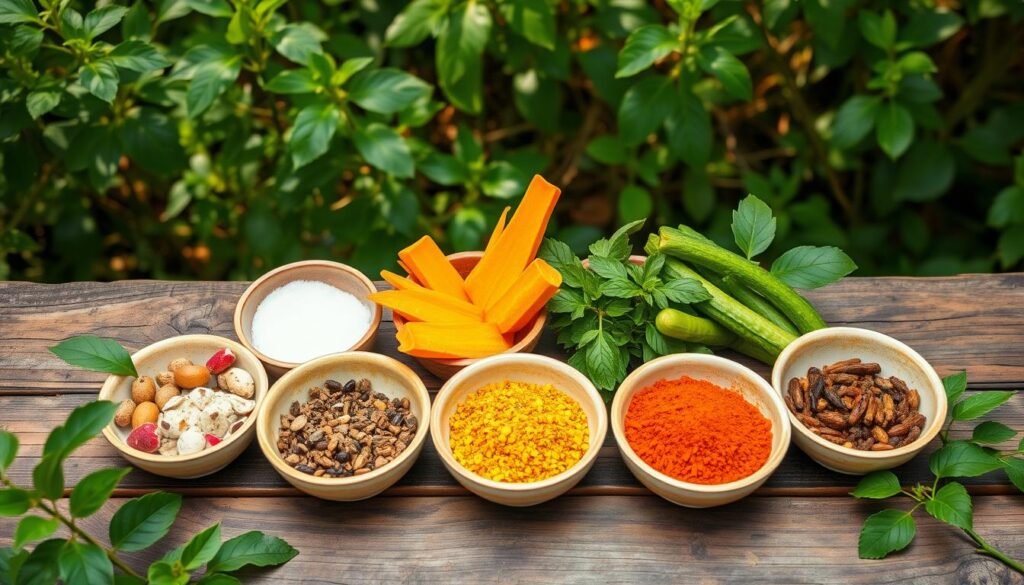The Ayurvedic diet is an ancient way of eating. It’s based on Ayurvedic medicine, which looks at the body’s energy balance. This diet gives you food tips based on your body type, or dosha.
It suggests eating whole foods and being mindful of what you eat. Eating foods that are in season is also key. By following the Ayurvedic diet, you might see better weight management and health.
Key Takeaways :Ayurvedic Diet
- The Ayurvedic diet is a holistic approach to nutrition based on ancient Indian Ayurvedic principles.
- It emphasizes personalized dietary recommendations based on an individual’s unique body type or dosha.
- The diet encourages the consumption of whole, minimally processed foods and mindful eating practices.
- Potential benefits of the Ayurvedic diet include weight management, chronic disease prevention, and improved overall health.
- Incorporating Ayurvedic lifestyle practices, such as spending time in nature and prioritizing rest, can further enhance the diet’s health benefits.
Understanding the Ancient Science of Ayurvedic Diet
The Ayurvedic principles are based on the balance of five elements: vayu (air), jala (water), akash (space), teja (fire), and prithvi (earth). These elements create three doshas: vata, pitta, and kapha. Each dosha controls different body functions.
The Five Elements and Their Role in Nutrition
The Ayurvedic diet focuses on balancing these doshas. It recognizes that everyone’s body is unique, shaped by the five elements. By knowing the elemental properties of foods, experts can help people find the best elemental nutrition for their health.
Understanding Doshas in Ayurvedic Practice
The doshas – vata, pitta, and kapha – affect our physical, mental, and emotional health. Knowing your dominant dosha is key. It helps tailor dietary and lifestyle choices for balance.
Core Principles of Ayurvedic Eating
The Ayurvedic diet focuses on whole, unprocessed foods. It aims to include all six tastes in meals and match food with the seasons. Mindful eating is also crucial, linking the mind, body, and spirit.
“Ayurveda is not just about the body, but also the mind and spirit. It’s a comprehensive system that addresses the whole person.”
Identifying Your Body Type for Optimal Nutrition

Ayurveda, an ancient Indian medicine, identifies three main body types or doshas: Vata, Pitta, and Kapha. Knowing your dominant dosha is key to finding the right nutrition and wellness through Ayurvedic principles.
Vata types are usually thin, creative, and face digestive problems. They can be moody and anxious. Pitta individuals are medium-built, smart, and might have inflammation and a big appetite. Kapha people are sturdy, calm, but can gain weight and have breathing issues.
| Dosha | Physical Characteristics | Emotional Traits | Dietary Needs |
|---|---|---|---|
| Vata | Slim, dry, and cold body; brown or wheatish complexion; thin, scanty hair | Emotionally sensitive, energetic, creative, but easily overwhelmed | Prefer warm, nourishing foods; avoid cold, dry, and light items |
| Pitta | Medium build, silky but thin hair, fair or reddish complexion | Medium emotional set points, strong leadership qualities, prone to conflict | Favor cooling, not overly spicy or sour foods; avoid excessive heat |
| Kapha | Well-developed, sturdy bodies; fair complexion, lustrous, and oily skin; thick, dark, wavy hair | Slow emotional metabolism, serene and patient, but prone to weight gain and breathing issues | Prefer light, dry, and warming foods; avoid heavy, oily, and cold items |
Finding out your dosha is the first step in Ayurvedic nutrition. Knowing your body type helps you adjust your diet and lifestyle. This supports your health and well-being.
“Ayurveda emphasizes the importance of identifying your body type to enhance mental, physical, and spiritual wellness.”
The Six Essential Tastes in Ayurvedic Diet

Ayurvedic cuisine focuses on six key tastes for balanced nutrition and health. These are sweet, sour, salty, pungent, bitter, and astringent. Each taste affects the body and mind differently. Eating a mix of these flavors helps meet nutritional needs, stops cravings, and boosts health.
Sweet, Sour, and Salty Tastes
The sweet taste, with earth and water, calms vata and pitta but can raise kapha. Sour taste, with water and fire, boosts pitta and kapha but lowers vata. Salty taste, with earth and fire, lowers vata but raises pitta and kapha.
Pungent, Bitter, and Astringent Tastes
Pungent taste, with fire and air, aids digestion and boosts blood flow but can upset pitta and vata. Bitter taste, with air and space, cools and cleanses, helping pitta and kapha. Astringent taste, with air and earth, is cool and firm but may cause gas in vata types.
Balancing Tastes for Optimal Health
Ayurvedic wisdom suggests eating all six tastes in each meal for balanced Ayurvedic tastes and balanced nutrition. The right mix of tastes depends on your dosha and current health. This approach ensures good digestion, nutrient uptake, and overall health.
Seasonal Eating According to Ayurveda

Ayurvedic philosophy teaches us to eat with nature’s rhythms. We align our diets with the seasons to support our bodies all year. This approach boosts digestion, immunity, and overall health.
The year is split into two periods with three seasons each, says Ayurveda. Each season has its own dietary needs for balance. For example, Spring calls for light, easy-to-digest foods like greens and detox foods.
| Season | Characteristics | Recommended Foods |
|---|---|---|
| Spring (Vasantha) | Kapha dosha aggravated, Agni in slow state | Fresh, leafy greens, detoxifying foods |
| Summer (Grishma) | Pitta dosha dominates, need for cooling, hydrating foods | Light, water-rich produce |
| Autumn (Sharat) | Vata dosha vitiated, Agni strengthens | Unctuous, sweet, and salty foods |
| Winter (Shishira) | Vata governs with strong Kapha undertones, need for warm, hearty meals | Warm soups, stews, and nuts |
Following these seasonal nutrition tips helps keep our bodies in balance. Ayurvedic experts suggest foods and treatments for each season. This keeps our Ayurvedic food cycle in sync with nature.
Food Combinations and Timing in Ayurvedic Diet

Ayurvedic principles offer great advice on the best foods to eat together and when to eat them. This helps improve how well we digest food and avoid digestive problems.
Compatible Food Pairings
Ayurveda suggests eating grains with veggies and proteins with non-starchy veggies. For example, basmati rice with sautéed greens or lentils with roasted root veggies is good. Spices and herbs in cooking also help make foods work better together.
Foods to Never Combine
- Fruit and dairy products (such as cheese, milk, or yogurt)
- Legumes and cheese
- Raw and cooked foods
- Melons (which should be eaten alone)
Some foods don’t mix well and can upset your stomach. But, if you’re used to eating certain foods together, your body might get used to it.
Optimal Meal Timing Guidelines
Ayurveda says eat your biggest meal at lunch when your body can digest best. Don’t eat too late at night and leave some time between meals for digestion. Adding fresh ginger and lassi after meals can also help your digestion.
| Recommended Meal Proportions | Quantity |
|---|---|
| Food | One-third of the stomach capacity |
| Liquid | One-third of the stomach capacity |
| Empty Space | One-third of the stomach capacity |
Following these Ayurvedic tips can make your digestion better and help you absorb nutrients more efficiently. This leads to a healthier life.
Mindful Eating Practices and Wellness Habits

Embracing mindful eating is key in the Ayurvedic lifestyle. It means eating slowly, chewing well, and focusing on your meal. This helps you enjoy your food more and appreciate the nourishment it gives.
Ayurveda also suggests a holistic approach to wellness. This includes yoga, meditation, enough sleep, and time in nature. These practices, along with a tailored diet, can lower stress, improve digestion, and boost your health.
Mindful eating in Ayurveda means eating in a calm place. It’s about being thankful for your food and stopping when you’re just right. This way, you connect better with your food and improve your overall health.
| Ayurvedic Lifestyle Practices | Benefits |
|---|---|
| Mindful Eating | Improved digestion, reduced stress, better satiety |
| Yoga | Enhanced physical and mental well-being, stress reduction |
| Meditation | Increased focus, reduced anxiety, improved sleep quality |
| Spending Time in Nature | Boosted mood, decreased inflammation, improved immune function |
By adopting these mindful eating habits, you start a journey towards holistic wellness. It’s a path to better physical, mental, and emotional health.
“The greatest healing therapy is to live in harmony with nature and within the wisdom of the ancient Ayurvedic traditions.”
Also Read : Benefits Of A Sugar Free Diet: How It Can Improve Your Health
Conclusion
The Ayurvedic diet focuses on nutrition in a holistic way. It tailors eating to your body type and current health needs. Even though some parts lack scientific proof, many of its ideas match today’s nutrition advice.
Eating whole foods, being mindful of what you eat, and following the seasons are key. These practices can lead to better health and happiness.
But, it’s crucial to keep an open mind when trying the Ayurvedic diet. Always think about your own health needs. Talk to doctors before making big changes to your diet.
By using the holistic nutrition and personalized health ideas of Ayurveda, you can live a balanced life. This approach helps you understand how food affects your body and well-being.
By following Ayurveda’s teachings, you start a path towards better health. It leads to a life that is more in tune with your body and health.
FAQs
Q: What is the ayurvedic diet?
A: The ayurvedic diet is based on the principles of Ayurvedic medicine, which has been practiced for thousands of years. It focuses on balancing the three doshas—vata, pitta, and kapha—through dietary choices, promoting overall health and wellness.
Q: How do I eat for my dosha?
A: To eat for your dosha, it’s important to identify which dosha is dominant in your body. Once you know your dosha, you can follow an ayurvedic diet plan that includes foods that balance your specific dosha. For example, people with vata may benefit from warm, moist foods, while those with pitta may need cooling foods.
Q: What are some benefits of the ayurvedic diet?
A: The benefits of the ayurvedic diet may include improved digestion, balanced energy levels, better weight management, enhanced mental clarity, and a strengthened immune system. Eating an ayurvedic diet can also help harmonize the mind and body, leading to overall well-being.
Q: Can I follow an ayurvedic vegetarian diet?
A: Yes, an ayurvedic diet can be vegetarian. Many ayurvedic recipes focus on fruits and vegetables, nuts and seeds, and whole grains. An ayurvedic vegetarian diet can still provide all the necessary nutrients while aligning with the principles of ayurvedic cooking.
Q: What foods are beneficial for vata dosha?
A: Foods for vata include warm, nourishing items such as cooked grains, root vegetables, healthy fats, and spices like turmeric and ginger. These foods help to balance vata’s cold and dry qualities, promoting stability and nourishment.
Q: How does the ayurvedic diet help with body weight management?
A: The ayurvedic diet may help with body weight by promoting mindful eating and the consumption of whole, nutrient-dense foods. By eating according to your dosha and focusing on balance, you can maintain a healthy body weight and metabolism.
Q: What are some common ayurvedic herbs used in ayurvedic cooking?
A: Common ayurvedic herbs used in ayurvedic cooking include turmeric, ginger, cumin, coriander, and fennel. These herbs are not only flavorful but also provide various health benefits, aiding digestion and enhancing overall health.
Q: How can an ayurvedic practitioner help me?
A: An ayurvedic practitioner can help by assessing your dosha and creating a personalized dietary and lifestyle plan. They can guide you in choosing the right foods, herbs, and practices to support your health and well-being based on the principles of ayurvedic medicine.
Q: What is the largest meal recommended in an ayurvedic diet plan?
A: Traditionally, the largest meal in an ayurvedic diet plan is often recommended to be eaten at lunchtime when digestion is strongest. This meal should include a balance of carbohydrates, proteins, and healthy fats, tailored to your specific dosha.
Source Links
- https://www.healthline.com/nutrition/ayurvedic-diet
- https://www.health.com/weight-loss/ayurvedic-diet
- https://www.everydayhealth.com/diet-nutrition/ayurvedic-diet/guide/
- https://pmc.ncbi.nlm.nih.gov/articles/PMC4815005/
- https://ayurveda.com/ayurveda-a-brief-introduction-and-guide/
- https://pmc.ncbi.nlm.nih.gov/articles/PMC5198827/
- https://www.dabur.com/ayurveda/ayurvedic-body-types
- https://www.ayurvedainstitute.co.uk/identifying-ayurvedic-body-types-what-are-they/
- https://www.sukhavatibali.com/the-6-tastes-a-guide-map-to-ultimate-nutrition/
- https://theayurvedicclinic.com/6-essential-tastes-in-ayurveda/
- https://www.dabur.com/blog/ayurvedic-diet/different-types-taste-their-roles-according-ayurveda
- https://www.artofliving.org/us-en/the-basics-of-ritucharya-ayurveda-secrets-of-seasonal-eating
- https://www.farmtrue.com/our-blog-updates/ayurvedic-seasonal-food-list
- https://www.ayurvedainstitute.co.uk/ayurvedic-seasonal-eating-wellbeing-guide/
- https://ayurveda.com/incompatible-food-combining/
- https://divyas.com/journals/an-ayurvedic-guide-to-food-combining/?srsltid=AfmBOoqXM6c0wQMzckDNmdgMmUHYKkB-7h7SoVzdZuslmdu8ncff574Z
- https://www.ayurvedainstitute.co.uk/what-is-meant-by-mindful-eating-in-ayurveda-and-what-is-its-role-in-holistic-healing/
- https://www.indraholistic.com/blog/ayurvedic-diet-for-balance-and-well-being
- https://mountaintopclinic.com/ayurvedic-diet-for-wellness-what-are-the-rules-to-follow/
- https://www.ayurvedacollege.net/blogs/ayurvedic-eating-habits-for-a-healthy-lifestyle
- https://www.webmd.com/balance/ayurvedic-treatments
- https://www.mountsinai.org/health-library/treatment/ayurveda








Leave A Comment